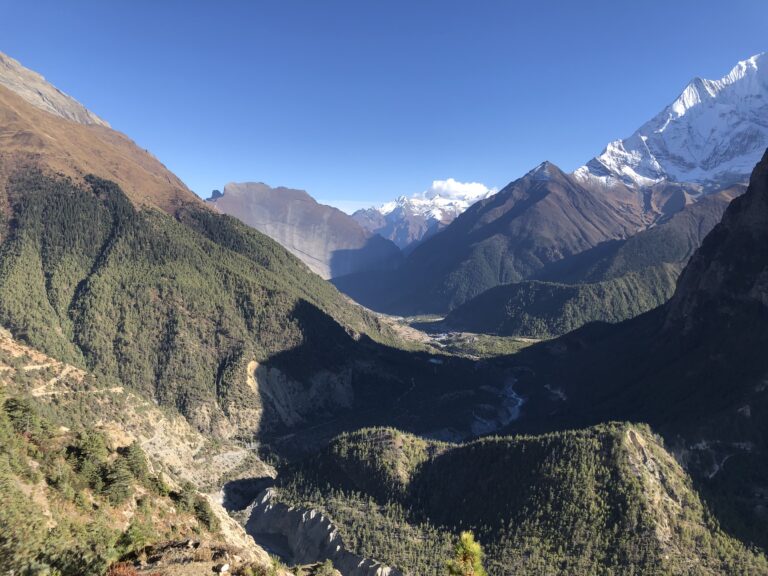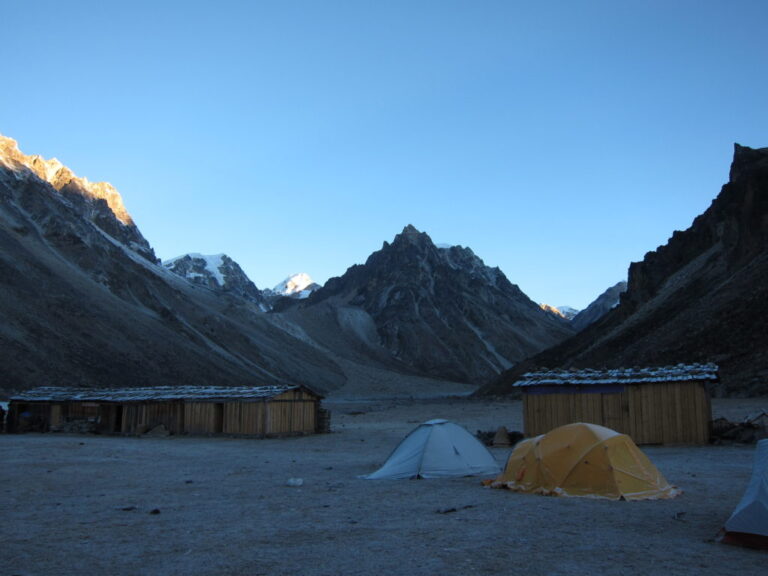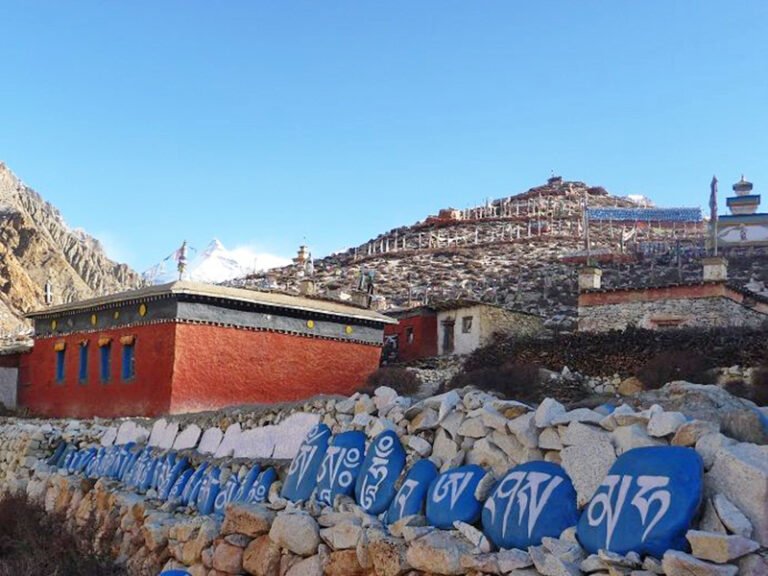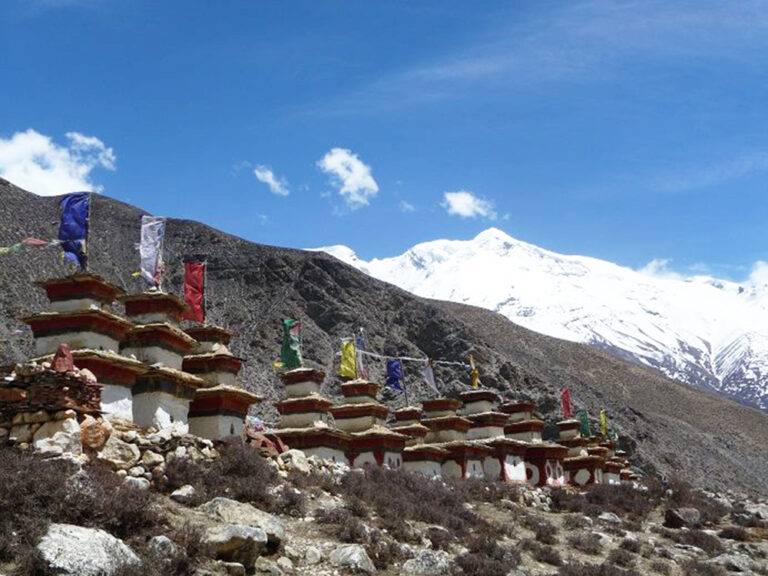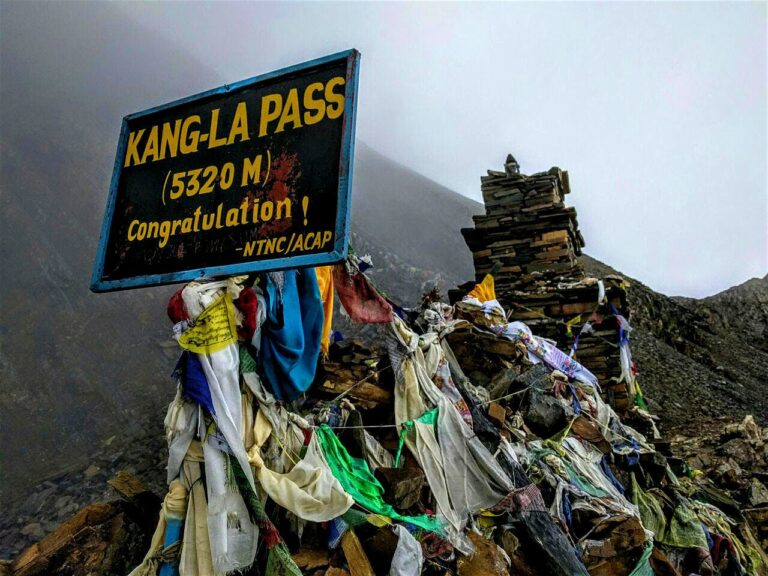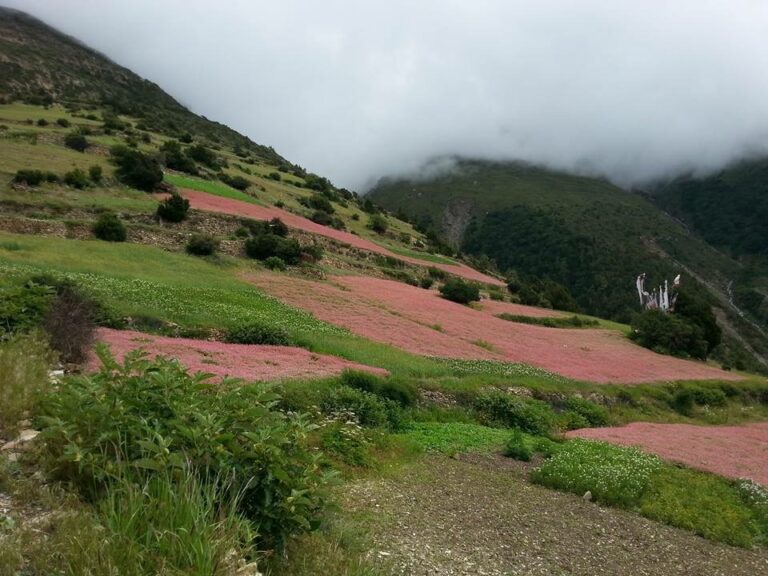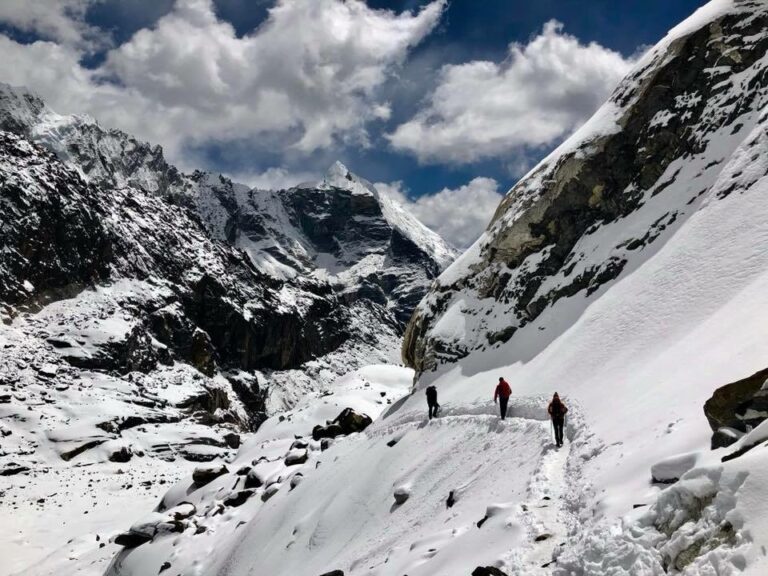Day 01 – We will pick you up from the Tribhuwan international airport in Kathmandu, on your arrival date and escort to the hotel. The hotel will be reserved in Thamel which is the main touristic zone in Kathmandu. After check-in hotel; your guide will brief a little bit over the trekking route, trekking gears, and whole programs.
Day 02 – You will explore some of the historical places and pilgrimage sites in Kathmandu valley such as Pashupatinath temple, Baudhanath stupa, Kathmandu Darbar square, and Swayambhunath stupa; which is also known as Monkey temple due to wandering hundreds of Monkeys around the temple compound.
Day 03 – Drive to Besishahar- Tall village 1700 m.a.s.l – We will drive approximately 5 to 7 hours to get Besishahar which is 175 kilometers far from Kathmandu city. During the driving period; we can see a beautiful view of Ganesh Himal, Manaslu and Annapurna mountain ranges and charms view of agricultural terraced field. After lunch in Besishahar, we will drive another three hours to get to Tall village. Tall
Day 04 – Trek to Nache village 2300 m.a.s.l – 6 hours walk – we will follow the classic Annapurna circuit trekking trail until Khotro village which may takes approximately two and a half hours. The trail is mostly flat and offers to see awesome Marshyangdi river, green pine forest, rocky hills, and some small villages. From here; The rocky steps trail gently ascends through the bamboo and pine forest until a suspension bridge which is a kind of viewpoint to see deep river gorge, Dharapni, and Bagar villages. From here; we walk through the pine forest to get Nache village; which a beautiful hamlet, located top of the hill with 40 households of Gurung people. spend overnight at homestay basis lodge.
Day 05 – Trek to Tache village 2340 m.a.s.l – 5 hours walk – Through the Nache village and across a small bailey bridge, we begin day three. a short detour will bring us to a stalagmite cave, an interesting small cavern of spiritual value. It is believed that monks meditated here in the past. continue walking through the forests for another one hour and arrive at Tache village, a small Gurung settlements. The village is home to a number of great homestays and we will be accommodated in one of them for the night. Mingle with locals and enjoy a traditional lunch. If we are interested then also we can visit the hot springs which may take about 20 minutes to get there.
Day 06 – Trek to Shongle village 3360 m.a.s.l – 7 hours walk – we wake up to the rising sun and take in the fresh air. we start a strenuous walks as we ascend uphill two and a half hours with beautiful views of Tache and Ghelinchowk to take away as memories, we will arrive at the saddle of Chonga danda which is kind of viewpoint that commands to see charm landscapes, Chonga river valley and flying Himalayan griffons in the sky. From here we descend through the pine forest to get Chonga river. from the Chonga river, we will ascend to the Shongle, an open space where we will set up our tent to spend a joyful night.
Day 07 – Trek to Kuchumro phedi 4525 m.a.s.l – 5 hours walk – After breakfast and hot drinks; we will head towards Kuchumro phedi with very fresh air and the giant view of rugged and rocky hills which are stunning our both hand side. We will walk approximately 45 minutes on the dewy trail then appear a small shepherd hut and then the trail gently ascends to the Kuchumro phedi through the forest of bamboo, Pine, and Rhododendron. Kuchumro phedi is a perfect place to set up a tent due to the beautiful camping ground and water source.
Day 08 – Trek to Namakyu 4600 m.a.s.l – 9 hours walk – We will start our trek earlier than previous days due to long walk and cross over the two passes called Kuchumro pass and Yarcha pass. The trail is mostly uphill and passes through the rhododendron forest until Kuchumro pass, along the trail we can see some wildlife like monkeys, deer, Himalayan that and many specious of birds and butterflies. The top of the Kuchumro offers to see the grand view of Manaslu, Lamjung Himal, and Annapurna mountain range. From here; we will walk down to cross the Yarcha pass where we will come across clandestine views of Kangaru Himal 6941m and Annapurna II 7937 meters tall. we will sleep one overnight in Namakyu.
Day 09 – Trek to Meta village 4635 m.a.s.l – 8 hours walk – In the morning; we can see the spectacular view of Lamjung Himal, Annapurna II, and Gangapurna Himal to the south, Kangaru Himal to the south-west and north side is a sight for sore eyes. Our journey starts with a flat trail for 10 minutes then descend for another 15 minutes to get a small glacial stream. From here; we have to climb up approximately two hours to get a top of the hill that commands to see a stunning view of Pisang peak 6091m. From here; onwards, it is a gradual walk to Meta pass 4800m and to Meta village. Thre are half dozens of guesthouses in Meta village and offers delicious Dall-Bhat and other meals.
Day 10 – Trek to Phu Village 4204 m.a.s.l – 6 hours walk – The trail from Meta to Phu village is moderate and not so far but still it takes about 6 hours due to high elevation. After an hour’s walk from Meta we come across the first of the former settlement of the Khampa people in a place called Jhunum which is now used as a winter home by residents of Naar village. The Khampa’s are people from Eastern, Tibet who were waging a guerrilla war against the Chinese in the 1960s using Nepali territory in Manang and Mustang as their base. From here, the trail ascends gradually to Phu village pass by two other ancient Khampa settlements called Chhekyu and Kyang. while we are heading to Phu village we will have the magnificent view of Himlung Himal, Kangaru Himal, Pisang peak, awesome rock formation, Phu gate and long Mani walls. There are a half dozens of Guesthouses and some homestays available in Phu village to spend a joyful night.
Day 11 – Exploration of Phu village and Tashi Lakhang monastery – There are hundreds of interesting things to see around the Phu village-like old stupas, women are weaving traditional carpets with sheep wool and ruin houses which are looks as though the village has been carved out from the hills behind it with the stone buildings almost being camouflaged by the cliff. The houses are built with rock and timber with mud plasters though there are now a few modern houses. The Tashi Lakshang monastery is located top of the hill; east-west of the Phu village that believed to have one of the oldest monument of the region and was famous for the edict by the late Rimpoche or head monk who accepted to stay in that monastery if the villagers stop to drink alcohol and tobacco.
Day 12 – Trek to Loang 4680 m.a.s.l – 6 hours walk – Today we have to cross a pass called Phu pass which is 5190 meters high above the sea level. The trail gently ascends from Phu village with a splendid view of Kangaru, Himlung, Bhrikuti Himal, and it’s neighbor peaks. The top of the Phu pass commands to see gigantic pasture land, superb view of snowcapped peaks, stunning huge rocky hills, grazing yaks and cows, flying Himalayan griffons, and blue sheep. The trail gently descends from here for approximately three hours to get a small wooden bridge and the rest of the trek take about to get yak herders camp area known as Loang where we will spend one overnight.
Day 13 – Trek to Chekchu 4410 m.a.s.l – 7 hours walk – Today also, we have to cross a pass known as Nar pass which is 5400 meters high above the sea level. The trail gently ascends from the Loang camp and takes approximately three hours to get top of the Nar pass. Along the trail we will have charm view of rocky hills, gigantic deserted land, wonderful rock formation and flying griffons, and vultures in the sky. From top of the Nar pass we can see a good view of Bhrikuti, Himlung, Kangaru towards the east, and Chulu and Annapurna range towards the southwest. After sights of this nature view we will descend through scree field about 1400 meters to get Chekchhu camp and stay one overnight here.
Day 14 – Trek to Nar village 4110 m.a.s.l – 5 hours walk – Our journey starts with the descended trail through the scree field and juniper bushy trail to get a suspension bridge and from there the trail gently ascends for two hours to get a small valley surrounded by hills where we can see mystic caves on the cliff. From here; we will climb again for three hours to get Nar village with snowcapped peaks, juniper forest, flying vultures and grazing yaks, Sheep, Cows, Goats and horses. There are dozens of good guesthouses in Nar village and offer us comfortable beds and delicious meals with warm hospitality.
Day 15 – Trek to Ngawal village 3610 m.a.s.l – 08 hours walk- via Kangla pass 5103m – Some trekkers use to sleep one overnight in The Kangla Phedi which is not so far from the Kangla pass so good idea will be to start the trek early in the morning and head towards directly to Ngawal village from Nar village. The trail is mostly gradual up until Kang la pass but although we may feel a little bit hard walk and takes about three hours to get top of the Kangla pass. When we approach top the pass, we will be greeted with panoramic views of Annapurna II, III, Iv, Gangapurna, Pisang peak, Glacier dome, Tarke Kang, Khangshar peak, series of Chulu peak, Lamjung Himal, Tilicho peak, Kangaru Himal, Himlung Himal, and awesome Manang village and Marshyangdi River. From here we will descend for 4 hours to get Ngwal village where the comfortable bedroom await for us.
Day 16 – Trek to Manang (3550m.a.s.l) – 05 hours walk – From here; you have two options to choose trail either lower or upper trail but still recommended trail is to choose upper trail because upper trail commands to see better mountain views. The trail passes through a small village known as Julu; which is probably the smallest village of the Annapurna region, consisting of 5 households. Trek from Ngawal to Manang takes about 05 hours and offers to see a panoramic view of Annapurna II, III, IV, Gangapurna, Chulu peak, Tilicho peak, Linga peak, Tarkekang, Glacier dome, Pisang peak and as well as far view of Manaslu. We will have our lunch in Bhraka village where we also can explore an old and beautiful monastery.
Day 17 – Trek to yak kharka (4100m.a.s.l) – 04 hours walk – you will head towards yak kharka ascending by the Gradual trail through the Tanki Manang and Gunsang village. The pleasant walk from Manang to Yak Kharka offers to see a panoramic chain of Annapurna ranges including Gangapurna, Pisang peak, Chulu peak, Thorong peak, Tarke Kang, Tilicho Peak, Khangsar Kang, Glacier Dome and its beautiful ranges.
Day 18 – Trek to Thorong Phedi (4450m.a.s.l) -3:30 hours – Thorong Phedi is not so far from Yak kharka but still it takes approximately three and half hours to get there due to high elevation where you may feel shortness of your breath. The trail ascends gradually to Thorong Phedi pass by a village called Ledar and a teashop. You will cross once the Thorong River and appear a teashop where you can sip some hot drinks then 45 minutes walk brings you to Thorong Phedi. There is a landslide between the teashop and Thorong Phedi so you have to pay big attention to safe with falling rocks. You will have your lunch in Thorong Phedi and if you are still fit and fine then you can head towards Thorong high camp which may take another one and twenty minutes.
Day 19– Trek over the Thorong-La pass (5416m.a.s.l) and trek down to Ranipauwa – 8 hours walk – you will start your trek earlier than previous days due to cross over the Thorong-La pass and long walk down to Ranipauwa village. The trail to Thorong -La is not really steep climb, the long zigzag trail ascends gradually on a roller or icy trail will depend on the season. After 04 hours walk from the guesthouse you will be top of the Thorong-La pass that purpose to see dramatic mountain views and gigantic deserted land into the Upper mustang. After snapping some photographs we will head towards Ranipauwa which may takes about three hours. There are numerous of good guesthouses in Ranipawa village and possible to have comfortable attached bathroom with running hot shower.
Day 20 – Trek to Kagbeni Via Jhong Putak (2820.a.s.l.) – 5 hours walk – There is a very popular Hindu pilgrimage site in Ranipauwa village called Muktinath temple where can be seen 108 taps, holy pool, and natural flaming gas inside the monastery so early in the morning you will visit the shrine and head down to Kagbeni village via Chyonkar, Jhong and Putak villages which are historical and ancient settlements and a part of the restricted area of Upper mustang but still you can walk with normal trekking permit for one day. Trek from Ranipauwa to Kagbeni would be really impressive due to walk on the deserted land, exploration of old monasteries, ruined old royal palace, and the stunning view of Nilgiri, Thapa peak, Tukuche peak, Muktinath peak, Thorong peak, Yakawakang peak and Dhaulagiri. You will have our lunch in Kagbeni after that you will explore the Kagbeni village; which offers to see old monastery and amazing houses, made of clay, wooden log, and stones.
Day 21 – Trek to Jomsom bazaar 2800 m.a.s.l – 3 hours walk – Today is the easiest day entire the whole trip due to walk on the flat trail. we will follow the Kali Gandaki river which is one of the holy River for Hindu people and known as the main source of ammonite. We will be in Jomsom at lunchtime so we will relax and hang around the small market.
Day 22 – Fly back to Pokhara – 25 minutes in the air – Escort to hotel – Early in the morning, we will fly back to Pokhara with a grand view of Nilgiri, Thapa peak, Tukuche peak, Dhaulagiri and Annapurna ranges. After land in Pokhara airport, we will escort to the hotel in lakeside.
Day 23 – 25 minutes flight or 7 hours drive – There are two options to go Kathmandu from Pokhara like take a short flight or 7 hours drive. The tourist bus leaves around 7 AM from the tourist bus park, located three kilometers far from Lakeside. The airplane takes 25 minutes to get Kathmandu and its commands to see alluring views of Annapurna, Dhaulagiri, Manaslu, Ganesh Himal, and Langtang Himal mountain ranges.
Day 24 – Departure to the homeland – after a successful trip of Annapurna seven passes trek you will fly back to your home with great experiences of Nepali culture, costumes, admirable mountain views, and rural lives that make you a story taller among your friends and colleges.
